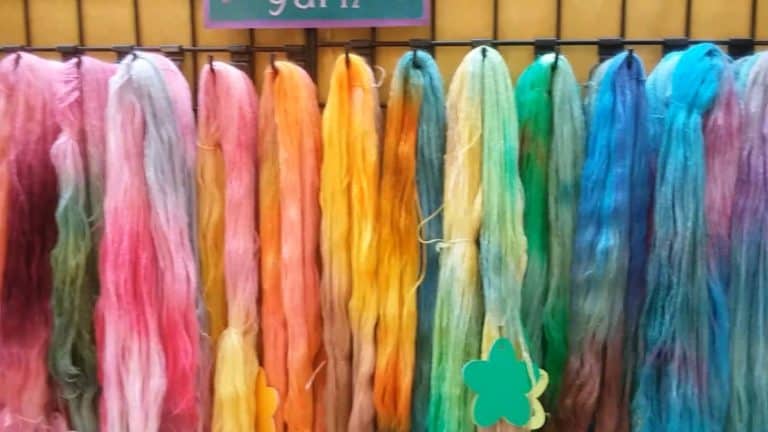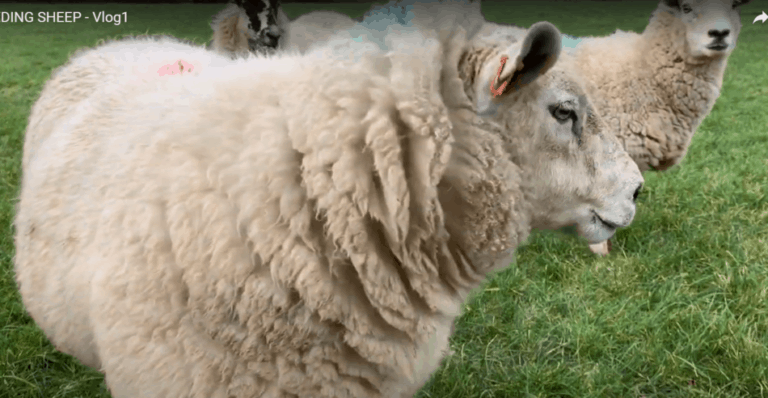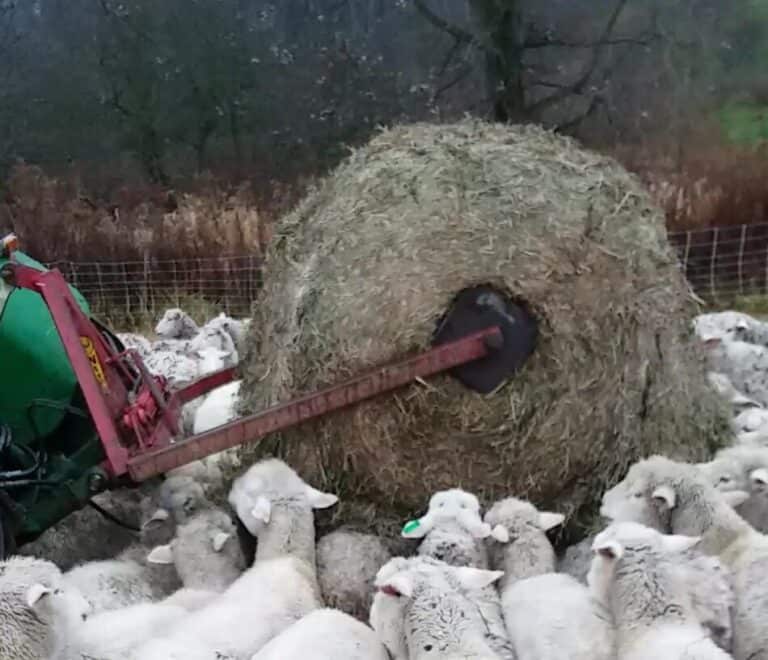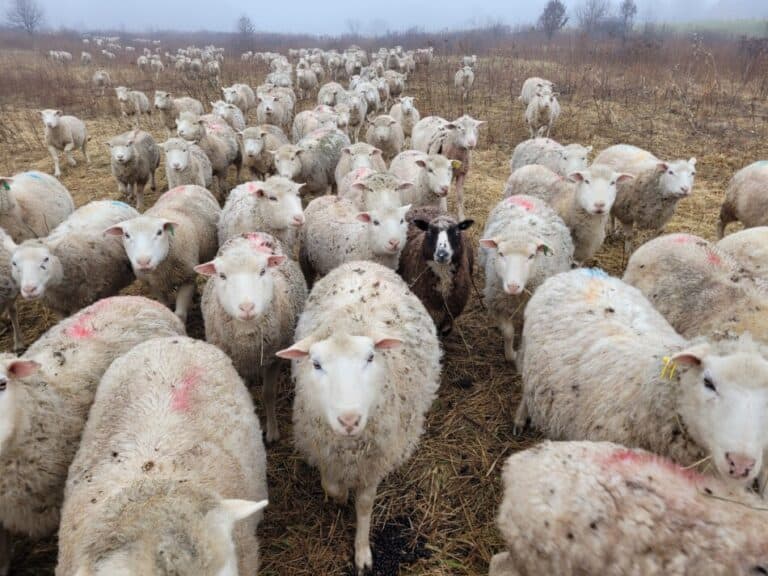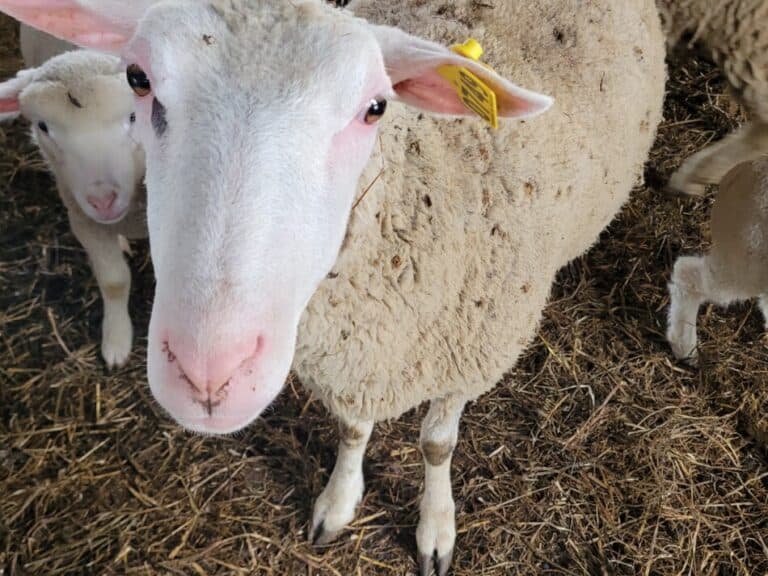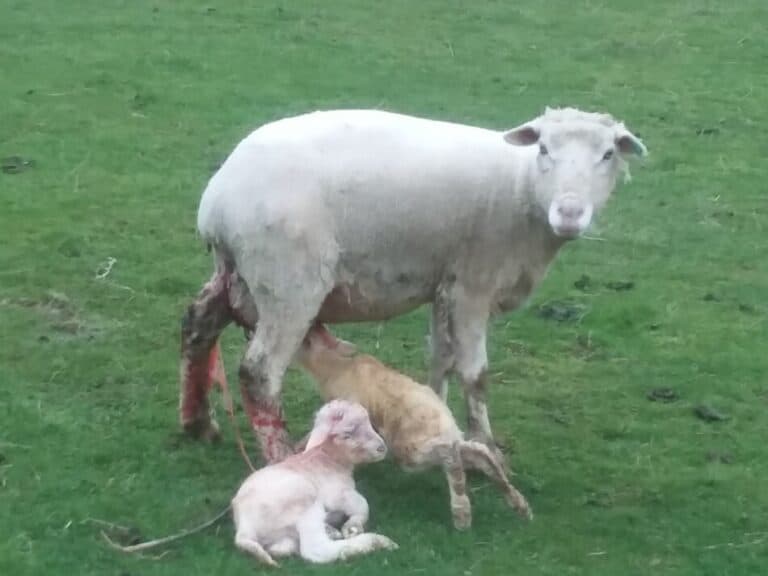Raising Sheep For Profit: Let’s Look At Some Numbers

| Expenses per head | Every year | First year |
| Purchasing sheep: ram | $600-1200 | |
| Purchasing sheep: ewe | $300-500 | |
| Feeding hay for the winter | $50 | $50 |
| Health care: deworming 3 times per year | $2.82 | $2.82 |
| Health care: shearing | $5.00 | $5.00 |
| One time purchases including gates, feeders, fencing, waterers, etc. | ??? | ??? |
| Income per head | Every year | First year |
| Selling market lambs* | $150* | $150* |
| Selling culls | $120 | $120 |
| Selling wool | $0 | $0 |
| Total income for year: one lamb per ewe | $151.80 | $151.80 |
| Total income for year: two lambs per ewe | $301.80 | $301.80 |
| Total expenses for the year per ewe | $57.82 | $357.82 (ewes) |
| Profit or loss per ewe with one lamb | $93.98 | -$206.02 |
| Profit or loss for per ewe with two lambs | $243.98 | -$56.02 |
Looking to get into raising sheep? It is a great time to be in the sheep raising business!
The demand seems to keep going up for high quality, well raised lambs.
So far, at least, sheep have not been industrialized like other popular livestock, keeping open a great opportunity for a smaller producer to get started in livestock.
So the outlook seems good but what about the price? How much do you make off of sheep per year and what does it take to make that money?
Sheep can be a profitable livestock enterprise when you keep down the costs and use good animal husbandry practices.
First off, and this is the catch to all livestock, prices are regional and seasonal.
This means that the prices we get here on a particular day may be very different than what you would get on the same day in your area. Look into it.
Market Reports are available to help you figure out the likely prices. Not surprisingly, prices are higher when there is a greater demand for what you are selling, like holidays, and lower in times of less demand.
Wondering how to read a market report?
Check out my article How Much Will My Lambs Sell For? I’ll walk you through reading a market report on sheep. It’s easy and will help you understand the price seasonality in your area.
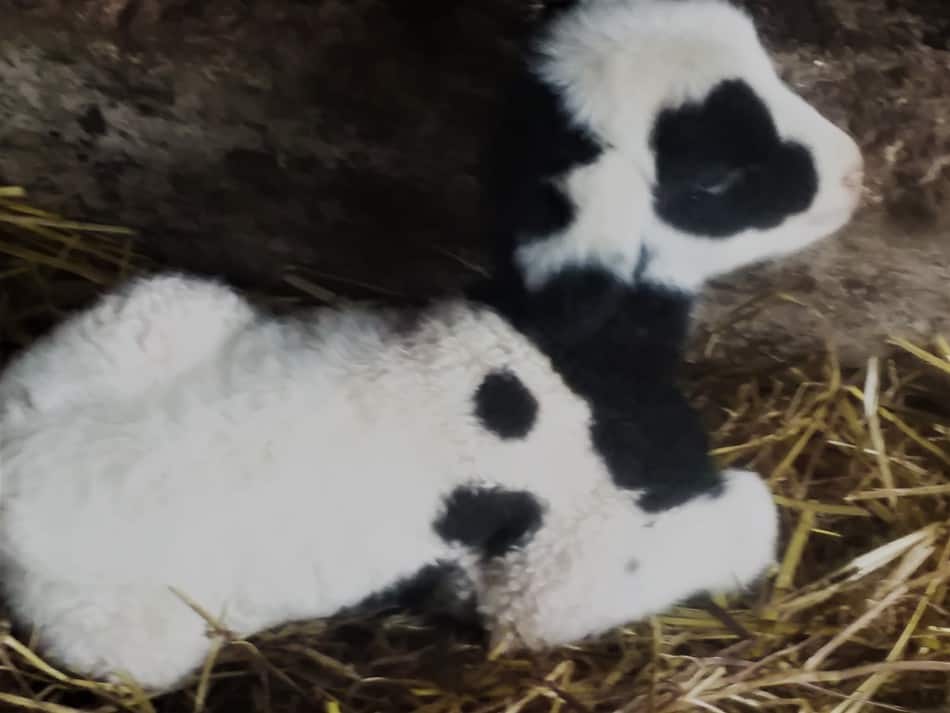
Costs involved in getting into the sheep business
When purchasing sheep, get the best quality you can afford
As always get the best quality breeding stock that you can afford.
If you have to keep your initial investment on the lower side, the best way to get the most results for your money is to purchase average ewes and a great ram.
Buying Sheep will go over all of the things you need to consider when purchasing your first flock.
A better ram will be the best use of your money because he is half of the genetics of the all the lambs to be born.
Like it or not the ewe is only half of the genetics of her own lambs. The overall genetics of the flock improve faster if you use great rams.
The ram cost varies considerably. Plan to spend $600-800 on a good ram. Great rams will cost significantly more, think closer to $1,000-1,200 or more.
Ewes should be in good shape and on the younger end of things like 2-3 years old.
Ewe lambs will be more of a challenge since they do not always breed to lamb at a year, so you will keep them and get no return your first year.
Stick with the mature ewe, she’s a veteran at this whole mom thing and will be more likely to do a good job for you.
A likely candidate for your starter flock will be around $300-500 each ewe. Once again, quality pays.
Update: in our area the prices for sheep are down from the hyped up highs of a few years ago. This means that you can get good quality breeding stock for a much more reasonable price now.
For instance, my husband was just at the auction yesterday (1/10/24) and saw a flock of good looking, due soon younger Katahdin ewes sell for between $200-300.
A few years ago, when sheep prices were high, these ewes would have brought $450-525 each. Not that either price is right, it’s more to show you that price varies with the market.
To be clear: if you are new to sheep, try to get your starter flock from a farm, not an auction. This just shows that getting into sheep is less costly now, at least around here.
Consider getting sheep from a flock on NSIP. (National Sheep Improvement Program) They focus on performance traits of sheep in the U.S.
We have a ram from an NSIP sale, he’s wonderful.
Occasionally, a flock of older ewes comes up for sale, ewes in the 5-6 year range.
These gals will know how to take care of a lamb and should still have a few productive years left before getting culled.
The advantage to an older ewe would be lower cost of getting started in sheep and gals who have repeatedly proven their worth as breeding stock.
Just make sure they are bred and in good shape if you are considering an older group.
Check their teeth, as sheep age their teeth wear down. If teeth and udder are good (both sides work), she’s keeping on weight and bred these gals are worth your consideration.
If you are buying registered sheep, make sure they are high quality
I’m about to ruffle some feathers here.
Many people assume that registered is also high quality, maybe, maybe not. It’s all about the performance of the sheep and the management they have been selected under.
Make sure if you are paying for registered sheep you are getting more than just a sheet of paper.
No matter what sheep you choose, you should be getting a flock that is the result of years of selection for great sheep that will make your sheep business a pleasure.
Feeding the sheep will be your biggest yearly expense
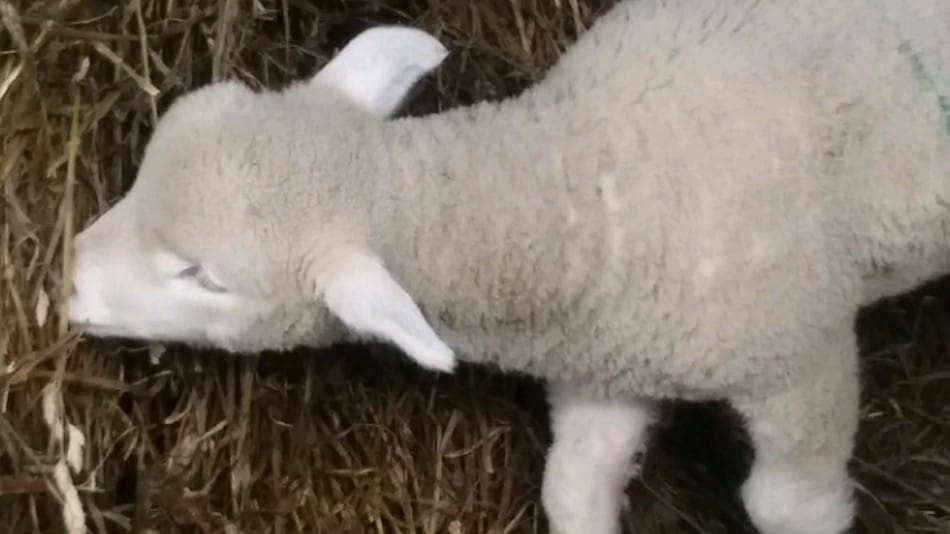
The biggest yearly cost for keeping sheep is feeding them, with the highest costs per day usually coming in the winter (non growing season) and the lowest costs per day when the flock is on pasture.
We pasture our sheep as much as we can however in our area of Ohio we still get a winter hay feeding season. This generally costs us $50 per ewe in hay, figuring 1/4 ton each per year of $200 a ton hay.
Usually this number is a little high, but since you never know the price of hay until you get to the time to buy it! Better to plan a bit of extra money so you can be sure your budget will last as long as the winter does!
Read How Many Bales Of Hay For Sheep for a look into figuring out how much hay your flock will need.
If you are renting pasture, then the cost of your rent will need added in here as well.
Grass is not free, if for no other reason than you could be doing something else with your land.
For this article I am leaving out the cost of the land, figuring that you already have access to potential grazing, unless you have to pay someone else to use it.
Fence will be needed for your sheep
Fencing is another area of getting started that will depend upon your situation, if you have fence already good deal. You are a lucky one!
Sheep are not hard to fence if you have woven wire or electric netting.
However, if you have single strand electric or high tensile fencing you will probably need to do something else to keep in your flock.
Getting netting to start pasturing your sheep is the least expensive way to get started with new fence.
You will need an energizer and a few rolls of netting.
Electronet For Sheep has my thoughts on the netting we use daily for the flock, if you are interested in the pros and cons of netting (or electric netting in general).
I like to have enough netting so that you can set up the next section of grass without letting out the sheep.
For instance, if you need two rolls to fence in your sheep get 4 rolls so they aren’t wandering around when you move pasture sections.
Establish a flock healthcare routine
For us the healthcare routine involves mainly deworming and shearing. Not a lot else is needed.
For the deworming we rotate around between the dewormers labeled for sheep to prevent parasite resistance (the dewormer not working any more).
The jug of dewormer costs $75 for 960 ml. Our ewes get 12 ml each per deworming. This puts the deworming cost at $0.94 per sheep per deworming.
A few points to keep in mind when figuring your costs, the dose is determined by the weight of the sheep.
Each brand of dewormer has a table to look up the weight to determine the dose, so bigger sheep need a bigger dose of dewormer and smaller sheep need less.
We also buy the larger size bottle which is less expensive per ml of product.
The final point is that your sheep will need dewormed multiple times per year, plan on 3-4 times per year.
As far as shearing is goes it will cost $5.00 per head to get them shorn by a professional. We had our flock shorn by a professional this spring, it cost $5.00 each plus an $120 set up fee. (Smaller flocks will cost more per sheep.)
You can of course learn to shear them yourself!
Actually, if you only have a few sheep this is not a bad idea, since a shearer will charge more per head for small flocks.
The clippers will be around $300 plus any additional blades will be $25 for the set (comb and cutter).
Most farm stores that sell show supplies will have clippers available, be sure to get the ones for sheep since the cattle clippers are not the same blades.
Other possible costs include medications and other normal health routine activities like hoof trimming.
Normally, we do neither, but the occasional ewe will have an overgrown hoof or two that will need trimmed off.
Hooves are made to break off when they grow too long.
The normal wear and tear of walking around on them plus the weight of the sheep will bend over the edges and the hoof will crack and break off at the new shorter length.
For sheep that are kept inside or sheep on soft ground this doesn’t always happen on it’s own. How often you’ll have to trim feet or if you have to trim at all depends upon the genetics of your flock.
Fixing overgrown hooves is definitely something you can do yourself.
The trimmers are called Hoof Rot Shears and will cost about $25.00. These trimmers should be available at most farm stores.
Income from your sheep flock is mostly market lambs
Selling the market lambs is your main money
Selling market lambs is the main income for sheep farmers in the U.S. Price varies with the time of year and the size of the lamb.
For a 80 pound lamb that is in good condition you will get around $150 each.
Generally, these lambs sell by the pound but once you do the math this is a good average per head for our area.
Referring to the chart above, this is where you will make your flock pay. Having twins to sell makes a huge difference in profit per ewe for the year.
Sell directly to customers
The other option for profiting from your lambs is to sell directly to customers.
Generally speaking, you will be able to keep more of the consumer dollar, which gets you more of a stable price than auction sales, since you are doing more of the work to get the lamb to the eaters.
If you are a people person, love sales and enjoy showing folks around your operation and marketing your lambs, direct to customer sales may be just what you are looking for, price wise.
Since we do not sell our lambs directly to customers at this time, I do not have any numbers for you on selling direct vs auction. It’s always an option for us (and you), but for right now, we do not sell this way.
Price per lamb is seasonal, off season pays more
You will not get $150 per lamb if you sell when everyone else is selling their lambs, usually, at the end of the grazing season.
If you add to the glut of lambs going through the sale at this time, you should expect to get more like $100 each.
We keep our lambs longer and feed them so we get $200-260 each starting in January.
We just sold a group of 8 that were 80 pounds each on 11/3/21 and got $256 each. For comparison, we sold a group of lambs this time last year and got $130 each.
This is a little earlier than we normally start selling, but these guys were looking good and the price is high now so we sold a group.
It does cost around $20 more per lamb to feed them, but since keeping them longer more than doubles the price, we think selling market lambs after the first of the year is the best plan.
Severe weather can be reflected in your price
Severe weather can be reflected in your lamb prices, even if the severe weather was not in your area.
Other parts of the country are just finishing up a rough year, quite a bit of the country (USA) had a drought for the grazing season.
This means no grass for the summer and no hay was made to feed the stock for the winter.
Folks in this situation tend to sell down the herd, or flock, in this case, to reduce numbers to a level that the owners can afford to feed.
These folks will be getting low prices, really low. This will happen occasionally in your area, too.
If you weren’t in the drought area, you may be thinking “what does this have to do with me?”
For the areas that were fortunate enough to not have the drought, we still get some of the after effects, since this type of situation tends to flood nearby markets with lambs.
This means, at the end of the grazing season, my prices are low, too. Will the price come up this year? Probably, but it’s definitely taking longer that usual and of course, nothing is guaranteed.
Selling breeding stock generates income
When you get your operation to where you have sheep that are doing well for you every year, now you could sell some breeding stock.
Please keep in mind that breeding stock means better than average sheep that someone else will be counting on to help them get started in livestock.
These sheep should be reliable breeders that you can confidently recommend to fellow sheep enthusiasts.
Be choosy here, don’t sell anything for breeding stock that you would not be happy to keep for yourself.
If I had to guess, less than half of your ewe lambs will make the cut and 5-10% of ram lambs are of high enough quality for you to attach to your reputation.
Around here a bred ewe close to lambing will bring $350-400.
Open (not bred) ewes will bring $200-300 or so and ewe and lambs and younger ewes will bring a bit more at around $250-400 each.
Since these gals are younger they will bring more than an older ewe, simply because they have more productive life left.
Rams are more money. All this depends upon the breed and the demand for that breed, but a good average is $600-800 for farm rams.
Established sheep breeders with provable results can easily command much higher prices for rams (and ewes) but it takes a while to prove yourself and your genetics.
Selling culls provides flock income
Once an animal stops performing to your standards it must be sold to keep making improvements in your operation.
Currently a cull ewe in good shape, so plenty of muscling, will bring around $120.00. The “in good shape” part is vital!
A cull ewe, or ram, that looks bad will bring a low price.
Sell your culls when they are in good shape to get the most money for them.
In past years, cull prices have not been great, but lately (2021) they are good, as long as the cull is in good shape (mainly has a good amount of weight).
Selling the wool is not a big money maker
Wool prices vary with the year as well. Additionally, the type of wool your sheep have determines the price you will get if you sell at a wool buyer.
I will put our average per ewe at $1.80 per fleece, going with a overall price of $0.20 per pound of wool.
Sadly, this year (2020) the price dropped to $0.02 per pound. Yikes! This didn’t even cover our gas costs to drive there, so I put $0 in the table above.
I have seen on the internet articles listing the average price of wool to be more like $1.47 per pound.
That was the case a few years ago, but no longer. Finer wools are paying more per pound, but none are bringing the $1.47 per pound now.
We use two wool buyers, one is an independent buyer for a company and the other is a wool cooperative.
Both are over an hour from here and both have their positives and negatives.
The independent buyer gives the same price for all wool. He puts the bags on the scale and pays according to the weight.
Last year the price was $0.20/pound for all wool, this year $0.02/pound. He does not sort the wool at all and pays you the same day with a check.
Wool price update for 2021: we got $0.05/pound for wool this year. Not great, at all, but better than the $0.02/pound!
The wool cooperative pays better but you wait on the money.
The cooperative sorts the fleeces individually (by hand) and weighs out how much wool you have of each grade, generally the finer wool pays better.
We got anywhere from $0.07/pound to $0.77/pound for the wool we took on that load.
I averaged the price per pound for the whole load and it was $0.33/pound. Noticeably higher, but you wait until the end of the year for the check to be sent out.
Update: the wool cooperative has closed so we are down to one option and with the low prices, sadly, we just toss the wool.
If we had a fine wool breed, the clip might be worth our time and effort to get it there, but as is, it isn’t worth the trip to the buyer.
Specialty wool sales generate income
It would be remiss of me to leave out the specialty wool sales as a potential income source for you and your flock.
Some fleeces are in very high demand and command a high price to go with the high demand. Check it out on the internet.
I have seen $75-100 for each fleece! Wow, that is a great price for high demand animal fiber, and that’s not even the top end price wise!
I love specialty wools and great natural colored fleeces. I just bought a Shetland fleece this past fall for $20 which was a low price for the day, most were more like $40-50 per fleece.
But, and this is a huge but, be aware these fleeces take year around attention to the diet and surroundings of the sheep.
Many fleeces need extra careful shearing and multiple coats (to keep chaff out of the wool) make a high quality fleece for hand crafters.
We have normal commercial wool, so aside from enjoying specialty wools, I have no experience producing them.
If you are thinking of high end wool sales get in touch with farmers who are successful at it and follow their methods.
Start by asking the farmers you buy your sheep from.
Sheep and Wool Festival will show you the specialty wool sale events around here. This article specifically cover the Great Lakes Sheep and Wool Festival in Wooster, Ohio.
Raising sheep can be profitable
Raising sheep can definitely be profitable. The more lambs you sell per ewe the more profitable your business will be.
Getting the sheep at the start is the most expensive part of the sheep business and is a one time expense.
If you keep your ewe lambs instead of selling them in order to grow your flock, you can get more economical replacement animals.
Keep in mind this will increase the head you will feed over the winter and decrease the number of market lambs sold.
Once you are past the first year, your flock can be profitable every year, as long as you do your part to keep them healthy and productive.
